In the dynamic landscape of laboratories and office establishments, ensuring the well-being of your employees and coworkers is paramount. Adhering to safety and regulatory standards helps you uphold legal and ethical obligations and foster a healthy work environment that promotes productivity and innovation.
In this blog, we’ll explore the main regulatory standards, common security risks, and enhanced safety features that labs and offices can implement to create a secure and reliable work environment. Let’s get started!
Understanding Safety Standards
Before starting with the specifics, it’s highly important to have a basic understanding of the regulatory standards that govern safety in labs and offices. Organizations must adhere to standards imposed by government or non-government safety industry safety specialists such as OSHA, CDC, ISO, ICC, NFPA, IEC, etc. Adhering to these standards forms the base that you can use to implement effective safety measures.
What Are Some Common Safety Risks in Labs and Offices?
Identifying potential risk factors is the first step toward a safer work environment. Laboratories may face hazards ranging from chemical exposures to biological threats, while offices might contend with ergonomic issues and fire hazards.
List of Common Safety Risks in Labs
- Chemical Exposure
- Biological Hazards
- Fire Hazards
- Equipment Malfunctions
- Sharp Objects
- Physical Strain
List of Common Safety Risks in Offices
- Ergonomic Issues
- Fire Safety
- Poor Entry and Exit Management
- Stress and Mental Health
- Electrical Hazards
- Inadequate First Aid Facilities
In practical terms, thousands of real-world examples emphasize the importance of mitigating these risks and the need for proactive safety measures.
Enhanced Safety Features
Lab Safety
Laboratories, with their unique set of challenges, can use AI-powered or enhanced safety features. Fume hoods, emergency eyewash stations, and meticulous waste disposal systems are critical components in lab safety. Lab owners should also focus on comprehensive training for lab personnel to ensure they understand and follow safety protocols.
Office Safety
In office environments, electrical & fire safety measures, easily accessible first aid kits, and safe emergency exits contribute to a safer place. Make sure that areas like coffee break zones or conference rooms have sufficient space to move around comfortably. Beyond these physical features, employee training is also equally important. Empowering your workforce with the information to identify and respond to potential hazards is vital for office safety.
Integrating Technology for Enhanced Safety
The integration of the right technology can be a game changer in labs and office safety enhancement. Sensor systems, real-time monitoring devices, and automated safety protocols revolutionize safety and regulatory standards. These technologies detect potential hazards and enable swift responses that reduce the likelihood of accidents.
Always Stay Ready To Face the Challenges
Despite the reliability of modern security measures and technology integration, we should always stay prepared to face any type of risk manually. According to a survey conducted among lab and office interior specialists, using the available space wisely impacts business outcomes.
Ensure that all the parts of your establishments are well organized and nothing hinders your employees’ worksite. Also, use proactive security measures and have a recovery plan ready.
Employee Training and Awareness
The human element is central to safety. With practical safety training sessions, you can ensure that the employees are well-versed in safety protocols. Cultivating a culture of safety awareness promotes a collective responsibility for maintaining a secure working environment.
Regulatory Compliance Checklist
To assist organizations in their journey toward safety excellence, here’s a checklist summarizing key safety features and regulatory compliance measures for labs and offices:
Conclusion
Prioritizing safety standards in labs and offices is not just a legal requirement; it is a commitment to the well-being of your workforce. It is crucial that you adhere to both local and global safety and regulatory guidelines when conducting your operations. This involves ensuring compliance with all relevant laws, regulations, and industry standards in the regions where you operate, as well as meeting any applicable international standards or best practices. By doing so, you can minimize risks and ensure the safety of people, products, and processes involved in your activities.


